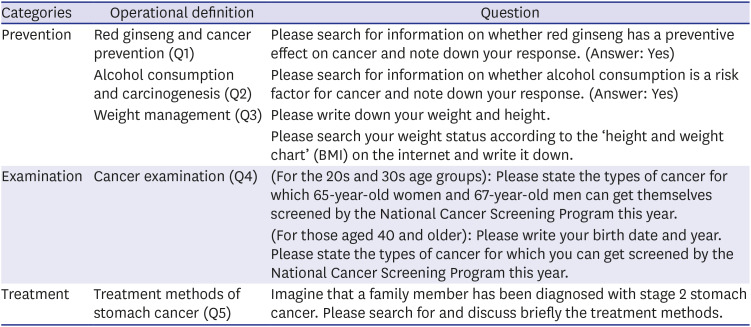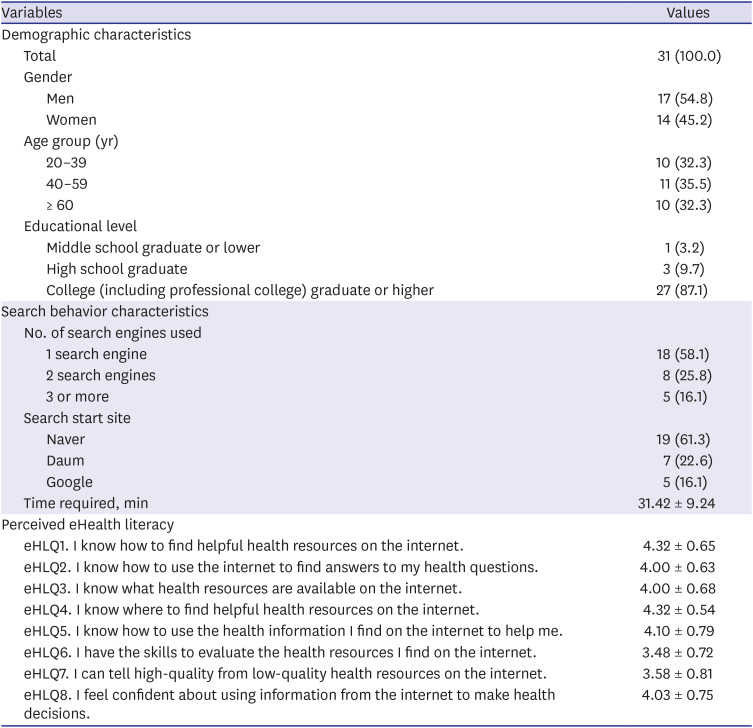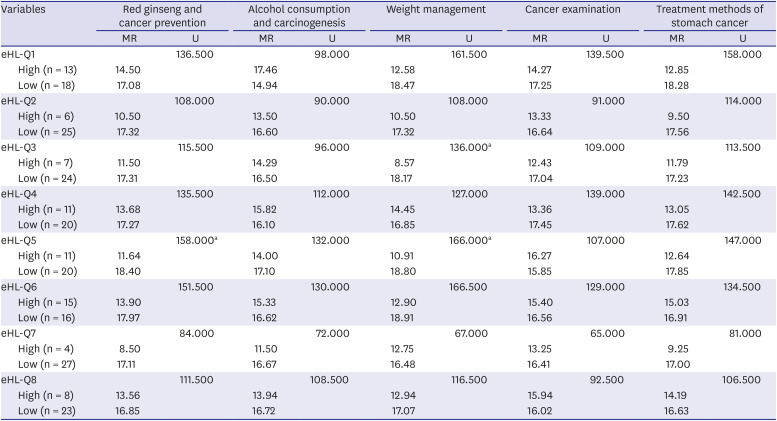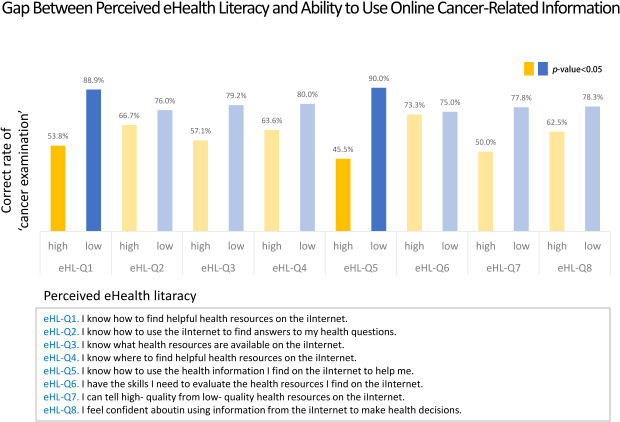2. Choung JT, Lee YS, Jo HS, Shim M, Lee HJ, Jung SM. What factors impact consumer perception of the effectiveness of health information sites? An investigation of the Korean National Health Information Portal. J Korean Med Sci. 2017; 32(7):1077–1082. PMID:
28581262.

3. Korea Internet & Security Agency. Survey on computer and internet usage. Update 2015. Accessed March 8, 2018.
http://isis.kisa.or.kr.
4. Chae J. Online cancer information seeking increases cancer worry. Comput Human Behav. 2015; 52:144–150.

5. Norman CD, Skinner HA. eHEALS: the eHealth Literacy Scale. J Med Internet Res. 2006; 8(4):e27. PMID:
17213046.

6. Zhang Y, Sun Y, Kim Y. The influence of individual differences on consumer's selection of online sources for health information. Comput Human Behav. 2017; 67:303–312.

7. Wong DK, Cheung MK. Online health information seeking and eHealth literacy among patients attending a primary care clinic in Hong Kong: a cross-sectional survey. J Med Internet Res. 2019; 21(3):e10831. PMID:
30916666.

8. Britt RK, Collins WB, Wilson K, Linnemeier G, Englebert AM. eHealth literacy and health behaviors affecting modern college students: a pilot study of issues identified by the American College Health Association. J Med Internet Res. 2017; 19(12):e392. PMID:
29258979.

9. Park DJ, Kwon MS, Choi J. The influence of health information orientation, attitude of internet health information, and e-Health literacy on personal health behaviors. J Public Relat Res. 2013; 17(3):379–413.
10. Kim SH, Son YJ. Relationships between eHealth literacy and health behaviors in Korean adults. Comput Inform Nurs. 2017; 35(2):84–90. PMID:
27258808.

11. Mitsutake S, Shibata A, Ishii K, Oka K. Associations of eHealth literacy with health behavior among adult internet users. J Med Internet Res. 2016; 18(7):e192. PMID:
27432783.

12. Xesfingi S, Vozikis A. eHealth literacy: in the quest of the contributing factors. Interact J Med Res. 2016; 5(2):e16. PMID:
27226146.

13. Noblin AM, Cortelyou-Ward K, Rutherford A. Weathering the storm: disaster preparedness and the Florida health information exchange. Int J Priv Health Inf Manag. 2016; 4(2):53–61.
14. van der Vaart R, van Deursen AJ, Drossaert CH, Taal E, van Dijk JA, van de Laar MA. Does the eHealth Literacy Scale (eHEALS) measure what it intends to measure? Validation of a Dutch version of the eHEALS in two adult populations. J Med Internet Res. 2011; 13(4):e86. PMID:
22071338.

15. Quinn S, Bond R, Nugent C. Quantifying health literacy and eHealth literacy using existing instruments and browser-based software for tracking online health information seeking behavior. Comput Human Behav. 2017; 69:256–267.

17. Pang PC, Chang S, Verspoor K, Pearce J. Designing health websites based on users' web-based information-seeking behaviors: a mixed-method observational study. J Med Internet Res. 2016; 18(6):e145. PMID:
27267955.

18. Song DJ, Choi JW, Kim K, Kim MS, Moon JM. Quasi-experiment study on effectiveness evaluation of health communication strategies. J Korean Med Sci. 2016; 31(7):1027–1036. PMID:
27365998.

19. Eysenbach G, Köhler C. How do consumers search for and appraise health information on the world wide web? Qualitative study using focus groups, usability tests, and in-depth interviews. BMJ. 2002; 324(7337):573–577. PMID:
11884321.

20. Hansen DL, Derry HA, Resnick PJ, Richardson CR. Adolescents searching for health information on the Internet: an observational study. J Med Internet Res. 2003; 5(4):e25. PMID:
14713653.

21. Shim M, Jo HS, Jung SM. The associations of online health information search and eHealth literacy with perceived information usefulness: analysis in the context of diet and weight control. Health Policy Manag. 2018; 28(2):119–127.
22. Seol J. A comparative study of internet search engines: Naver versus Google. J Commun Sci. 2011; 11(1):157–186.
23. Blanch-Hartigan D, Blake KD, Viswanath K. Cancer survivors' use of numerous information sources for cancer-related information: does more matter? J Cancer Educ. 2014; 29(3):488–496. PMID:
24699921.

24. Maloney EK, D'Agostino TA, Heerdt A, Dickler M, Li Y, Ostroff JS, et al. Sources and types of online information that breast cancer patients read and discuss with their doctors. Palliat Support Care. 2015; 13(2):107–114. PMID:
24182945.

25. Zhang S, O'Carroll Bantum E, Owen J, Bakken S, Elhadad N. Online cancer communities as informatics intervention for social support: conceptualization, characterization, and impact. J Am Med Inform Assoc. 2017; 24(2):451–459. PMID:
27402140.

26. Jo HS, Song TM, Kim BG. Analysis of the factors affecting consumer acceptance of accredited online health information. J Korean Med Sci. 2017; 32(11):1757–1763. PMID:
28960026.

27. Gilstad H. Toward a comprehensive model of eHealth literacy. In : Proceedings of the 2nd European Workshop on Practical Aspects of Health Informatics; 2014 May 19–20; Trondheim, Norway. place unknown: CEUR-WS.org;2014. p. 63–72.
28. Nguyen J, Moorhouse M, Curbow B, Christie J, Walsh-Childers K, Islam S. Construct validity of the eHealth Literacy Scale (eHEALS) among two adult populations: a Rasch analysis. JMIR Public Health Surveill. 2016; 2(1):e24. PMID:
27244771.










 PDF
PDF Citation
Citation Print
Print




 XML Download
XML Download